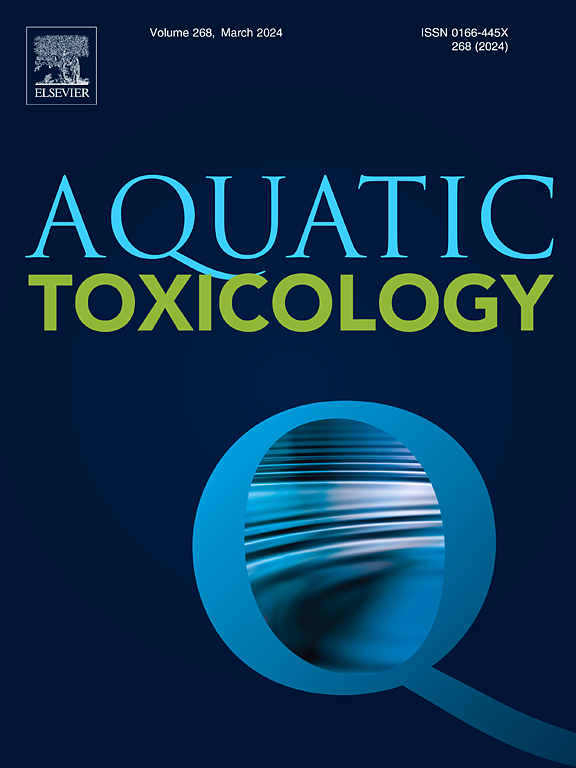慢性PFAS暴露可诱导欧洲鲈鱼(Squalius cephalus) (Linnaeus, 1758)肾脏中作为抗氧化防御的硒依赖性谷胱甘肽过氧化物酶和过氧化氢酶的激活
IF 4.3
2区 环境科学与生态学
Q1 MARINE & FRESHWATER BIOLOGY
引用次数: 0
摘要
威尼托大区(意大利)是全氟烷基和多氟烷基物质(PFAS)污染最严重的地区之一,这些污染物因其环境持久性和在动物组织中的生物蓄积潜力而日益引起关注。因此,有必要研究它们对生活在受污染河流中的淡水鱼的影响,特别是在抗氧化系统水平上的影响,因为已知PFAS会导致活性氧(ROS)产生的不平衡,从而增加氧化应激的风险。本研究考察了慢性暴露于三种不同环境浓度的PFAS在欧洲鲟鱼(头鲨)中引发的生理反应。这些位点被归类为“对照”(PFAS浓度<;5 ng/L)、低污染(5.64 ng/L)和高污染(582.6 ng/L)。对肾脏进行了生化和分子分析,肾脏是外源生物积累的主要器官之一。在活性蛋白和mRNA转录水平上量化过氧化氢酶(CAT)和硒依赖性谷胱甘肽过氧化物酶(Se-GPXs)的表达。结果证实了抗氧化防御的激活,以对抗pfas诱导的氧化应激风险。在特定的细胞内区室中,酶的生物合成存在差异诱导:“低污染”位点的过氧化物酶体中存在CAT,“高污染”位点的细胞质中存在Se-GPXs。gpx1基因是唯一的mRNA水平与活性蛋白相对应的亚型,表明在高PFAS浓度下,gpx1基因对Se-GPXs的生物合成贡献最大。相反,gpx4在“低污染”位点增加了转录水平,这与蛋白质含量的增加不匹配,这使我们假设特定的细胞质mrna -蛋白质复合物(称为应激颗粒)参与了gpx4的暂时沉默。本文章由计算机程序翻译,如有差异,请以英文原文为准。
Chronic PFAS exposure induces the activation of selenium-dependent glutathione peroxidases and catalase as antioxidant defences in the European chub (Squalius cephalus) (Linnaeus, 1758) kidney
The Veneto Region (Italy) experienced one of the heaviest contaminations by per- and polyfluoroalkyl substances (PFAS), pollutants of emerging concern due to their environmental persistence and bioaccumulation potential in animal tissues. Hence, there is a need to study their impact on freshwater fish inhabiting contaminated rivers, particularly at the level of the antioxidant system, since PFAS are known to cause an imbalance in reactive oxygen species (ROS) production, thereby increasing the risk of oxidative stress. This study examines the physiological responses triggered by chronic exposure to three distinct environmental concentrations of PFAS in the European chub (Squalius cephalus). The sites were classified as “control” (with a PFAS concentration < 5 ng/L), “low polluted” (5.64 ng/L) and “highly polluted” (582.6 ng/L). Biochemical and molecular analyses were performed on the kidney, one of the main organs for xenobiotic bioaccumulation. The catalase (CAT) and selenium-dependent glutathione peroxidases (Se-GPXs) expression was quantified at both active protein and mRNA transcript levels. Results confirm the activation of antioxidant defences against the risk of PFAS-induced oxidative stress. There is a differential induction in the biosynthesis of enzymes inside specific intracellular compartments: CAT in peroxisomes in the “low polluted” site and Se-GPXs in the cytoplasm in the “highly polluted” one. The gene gpx1 was the only isoform whose mRNA level corresponded to that of the active protein, suggesting the highest contribution to the biosynthesis of Se-GPXs at high PFAS concentrations. Conversely, gpx4 increased its transcription level in the “low polluted” site, which didn’t match with an increase in protein content, leading us to hypothesise an involvement of specific cytoplasmic mRNA-protein complexes, called stress granules, acting in the temporary silencing of gpx4.
求助全文
通过发布文献求助,成功后即可免费获取论文全文。
去求助
来源期刊

Aquatic Toxicology
环境科学-毒理学
CiteScore
7.10
自引率
4.40%
发文量
250
审稿时长
56 days
期刊介绍:
Aquatic Toxicology publishes significant contributions that increase the understanding of the impact of harmful substances (including natural and synthetic chemicals) on aquatic organisms and ecosystems.
Aquatic Toxicology considers both laboratory and field studies with a focus on marine/ freshwater environments. We strive to attract high quality original scientific papers, critical reviews and expert opinion papers in the following areas: Effects of harmful substances on molecular, cellular, sub-organismal, organismal, population, community, and ecosystem level; Toxic Mechanisms; Genetic disturbances, transgenerational effects, behavioral and adaptive responses; Impacts of harmful substances on structure, function of and services provided by aquatic ecosystems; Mixture toxicity assessment; Statistical approaches to predict exposure to and hazards of contaminants
The journal also considers manuscripts in other areas, such as the development of innovative concepts, approaches, and methodologies, which promote the wider application of toxicological datasets to the protection of aquatic environments and inform ecological risk assessments and decision making by relevant authorities.
 求助内容:
求助内容: 应助结果提醒方式:
应助结果提醒方式:


